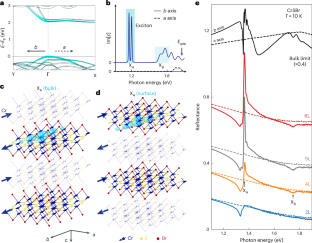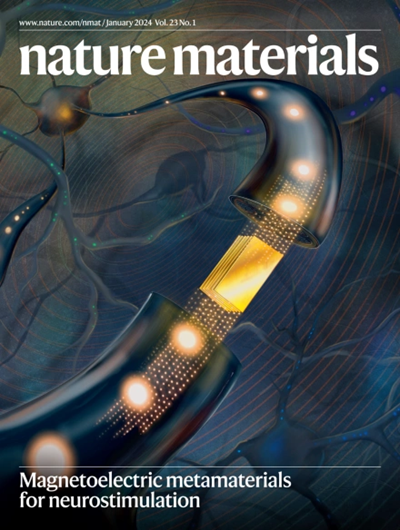Magnetically confined surface and bulk excitons in a layered antiferromagnet
IF 38.5
1区 材料科学
Q1 CHEMISTRY, PHYSICAL
引用次数: 0
Abstract
The discovery of two-dimensional van der Waals magnets has greatly expanded our ability to create and control nanoscale quantum phases. A unique capability emerges when a two-dimensional magnet is also a semiconductor that features tightly bound excitons with large oscillator strengths that fundamentally determine the optical response and are tunable with magnetic fields. Here we report a previously unidentified type of optical excitation—a magnetic surface exciton—enabled by the antiferromagnetic spin correlations that confine excitons to the surface of CrSBr. Magnetic surface excitons exhibit stronger Coulomb attraction, leading to a higher binding energy than excitons confined in bulk layers, and profoundly alter the optical response of few-layer crystals. Distinct magnetic confinement of surface and bulk excitons is established by layer- and temperature-dependent exciton reflection spectroscopy and corroborated by ab initio many-body perturbation theory calculations. By quenching interlayer excitonic interactions, the antiferromagnetic order of CrSBr strictly confines the bound electron–hole pairs within the same layer, regardless of the total number of layers. Our work unveils unique confined excitons in a layered antiferromagnet, highlighting magnetic interactions as a vital approach for nanoscale quantum confinement, from few layers to the bulk limit. The emergence of magnetically confined surface excitons enabled by antiferromagnetic spin correlations is reported, which leads to the confinement of excitons to the surface of layered antiferromagnet CrSBr.


层状反铁磁体中的磁约束表面和体激子
二维范德华磁体的发现极大地扩展了我们创造和控制纳米级量子相的能力。当二维磁体也是半导体时,一种独特的能力就出现了,这种半导体具有紧密结合的激子,具有大的振荡器强度,从根本上决定了光学响应,并且可以随磁场调节。在这里,我们报告了一种以前未被识别的光激发类型-磁性表面激子-由反铁磁自旋相关实现,将激子限制在CrSBr表面。磁性表面激子表现出更强的库仑引力,比体层中的激子具有更高的结合能,并深刻地改变了少层晶体的光学响应。通过层依赖和温度依赖的激子反射光谱建立了表面激子和体激子的明显磁约束,并通过从头算多体微扰理论计算得到了证实。通过猝灭层间激子相互作用,CrSBr的反铁磁顺序严格限制了同一层内的束缚电子-空穴对,而不管层数。我们的工作揭示了层状反铁磁体中独特的受限激子,突出了磁相互作用作为纳米级量子限制的重要方法,从几层到体限制。
本文章由计算机程序翻译,如有差异,请以英文原文为准。
求助全文
约1分钟内获得全文
求助全文
来源期刊

Nature Materials
工程技术-材料科学:综合
CiteScore
62.20
自引率
0.70%
发文量
221
审稿时长
3.2 months
期刊介绍:
Nature Materials is a monthly multi-disciplinary journal aimed at bringing together cutting-edge research across the entire spectrum of materials science and engineering. It covers all applied and fundamental aspects of the synthesis/processing, structure/composition, properties, and performance of materials. The journal recognizes that materials research has an increasing impact on classical disciplines such as physics, chemistry, and biology.
Additionally, Nature Materials provides a forum for the development of a common identity among materials scientists and encourages interdisciplinary collaboration. It takes an integrated and balanced approach to all areas of materials research, fostering the exchange of ideas between scientists involved in different disciplines.
Nature Materials is an invaluable resource for scientists in academia and industry who are active in discovering and developing materials and materials-related concepts. It offers engaging and informative papers of exceptional significance and quality, with the aim of influencing the development of society in the future.
 求助内容:
求助内容: 应助结果提醒方式:
应助结果提醒方式:


